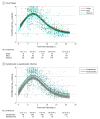Association of mRNA Vaccination With Clinical and Virologic Features of COVID-19 Among US Essential and Frontline Workers
- PMID: 36255426
- PMCID: PMC9579910
- DOI: 10.1001/jama.2022.18550
Association of mRNA Vaccination With Clinical and Virologic Features of COVID-19 Among US Essential and Frontline Workers
Abstract
Importance: Data on the epidemiology of mild to moderately severe COVID-19 are needed to inform public health guidance.
Objective: To evaluate associations between 2 or 3 doses of mRNA COVID-19 vaccine and attenuation of symptoms and viral RNA load across SARS-CoV-2 viral lineages.
Design, setting, and participants: A prospective cohort study of essential and frontline workers in Arizona, Florida, Minnesota, Oregon, Texas, and Utah with COVID-19 infection confirmed by reverse transcriptase-polymerase chain reaction testing and lineage classified by whole genome sequencing of specimens self-collected weekly and at COVID-19 illness symptom onset. This analysis was conducted among 1199 participants with SARS-CoV-2 from December 14, 2020, to April 19, 2022, with follow-up until May 9, 2022, reported.
Exposures: SARS-CoV-2 lineage (origin strain, Delta variant, Omicron variant) and COVID-19 vaccination status.
Main outcomes and measures: Clinical outcomes included presence of symptoms, specific symptoms (including fever or chills), illness duration, and medical care seeking. Virologic outcomes included viral load by quantitative reverse transcriptase-polymerase chain reaction testing along with viral viability.
Results: Among 1199 participants with COVID-19 infection (714 [59.5%] women; median age, 41 years), 14.0% were infected with the origin strain, 24.0% with the Delta variant, and 62.0% with the Omicron variant. Participants vaccinated with the second vaccine dose 14 to 149 days before Delta infection were significantly less likely to be symptomatic compared with unvaccinated participants (21/27 [77.8%] vs 74/77 [96.1%]; OR, 0.13 [95% CI, 0-0.6]) and, when symptomatic, those vaccinated with the third dose 7 to 149 days before infection were significantly less likely to report fever or chills (5/13 [38.5%] vs 62/73 [84.9%]; OR, 0.07 [95% CI, 0.0-0.3]) and reported significantly fewer days of symptoms (10.2 vs 16.4; difference, -6.1 [95% CI, -11.8 to -0.4] days). Among those with Omicron infection, the risk of symptomatic infection did not differ significantly for the 2-dose vaccination status vs unvaccinated status and was significantly higher for the 3-dose recipients vs those who were unvaccinated (327/370 [88.4%] vs 85/107 [79.4%]; OR, 2.0 [95% CI, 1.1-3.5]). Among symptomatic Omicron infections, those vaccinated with the third dose 7 to 149 days before infection compared with those who were unvaccinated were significantly less likely to report fever or chills (160/311 [51.5%] vs 64/81 [79.0%]; OR, 0.25 [95% CI, 0.1-0.5]) or seek medical care (45/308 [14.6%] vs 20/81 [24.7%]; OR, 0.45 [95% CI, 0.2-0.9]). Participants with Delta and Omicron infections who received the second dose 14 to 149 days before infection had a significantly lower mean viral load compared with unvaccinated participants (3 vs 4.1 log10 copies/μL; difference, -1.0 [95% CI, -1.7 to -0.2] for Delta and 2.8 vs 3.5 log10 copies/μL, difference, -1.0 [95% CI, -1.7 to -0.3] for Omicron).
Conclusions and relevance: In a cohort of US essential and frontline workers with SARS-CoV-2 infections, recent vaccination with 2 or 3 mRNA vaccine doses less than 150 days before infection with Delta or Omicron variants, compared with being unvaccinated, was associated with attenuated symptoms, duration of illness, medical care seeking, or viral load for some comparisons, although the precision and statistical significance of specific estimates varied.
Conflict of interest statement
Figures


References
-
- Iuliano AD, Brunkard JM, Boehmer TK, et al. . Trends in disease severity and health care utilization during the early omicron variant period compared with previous SARS-CoV-2 high transmission periods: United States, December 2020-January 2022. MMWR Morb Mortal Wkly Rep. 2022;71(4):146-152. doi:10.15585/mmwr.mm7104e4 - DOI - PMC - PubMed
Publication types
MeSH terms
Substances
Supplementary concepts
Grants and funding
LinkOut - more resources
Full Text Sources
Medical
Miscellaneous

